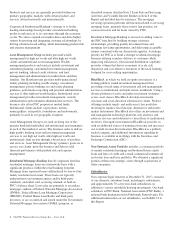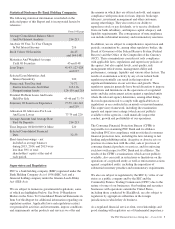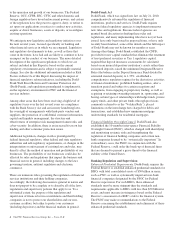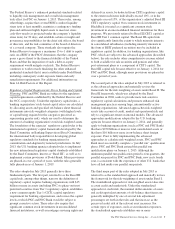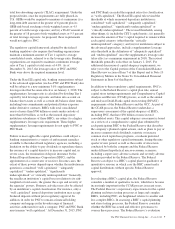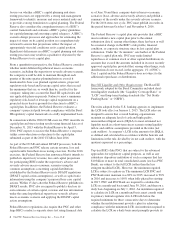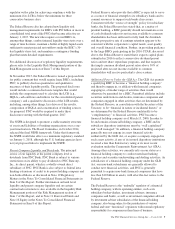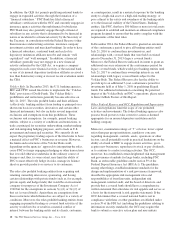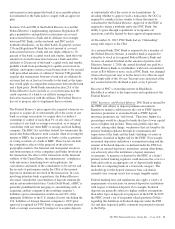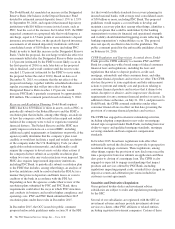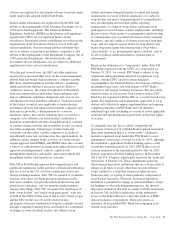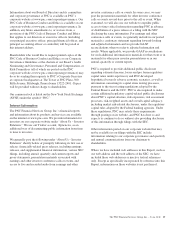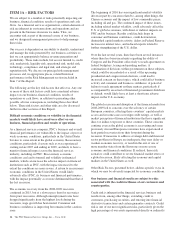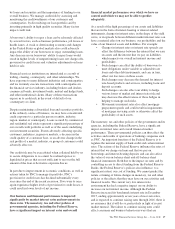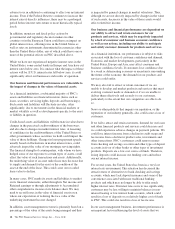PNC Bank 2015 Annual Report Download - page 26
Download and view the complete annual report
Please find page 26 of the 2015 PNC Bank annual report below. You can navigate through the pages in the report by either clicking on the pages listed below, or by using the keyword search tool below to find specific information within the annual report.
focuses on whether a BHC’s capital planning and stress
testing processes are supported by a strong risk management
framework to identify, measure and assess material risks and
to provide a strong foundation to capital planning. The Federal
Reserve also considers the comprehensiveness of a BHC’s
control framework and evaluates a BHC’s policy guidelines
for capital planning and assessing capital adequacy. A BHC’s
scenario design processes and approaches for estimating the
impact of stress on its capital position are comprehensively
reviewed to ensure that projections reflect the impact of
appropriately stressful conditions on its capital position.
Significant deficiencies in a BHC’s capital planning and stress
testing processes may result in a qualitative objection by the
Federal Reserve to its capital plan.
From a quantitative perspective, the Federal Reserve considers
whether under different hypothetical macro-economic
scenarios, including the supervisory severely adverse scenario,
the company would be able to maintain throughout each
quarter of the nine quarter planning horizon, even if it
maintained its base case planned capital actions, projected
regulatory risk-based and leverage capital ratios that exceed
the minimums that are, or would then be, in effect for the
company, taking into account the Basel III capital rules and
any applicable phase-in periods. Failure to meet a minimum
regulatory risk-based or leverage capital requirement on a
projected stress basis is grounds for objection to a BHC’s
capital plan. In addition, the Federal Reserve evaluates a
company’s projected path towards compliance with the Basel
III regulatory capital framework on a fully implemented basis.
In connection with the 2016 CCAR exercise, PNC must file its
capital plan and stress testing results using financial data as of
December 31, 2015 with the Federal Reserve by April 5,
2016. PNC expects to receive the Federal Reserve’s response
(either a non-objection or objection) to the capital plan
submitted as part of the 2016 CCAR in June 2016.
As part of the CCAR and annual DFAST processes, both the
Federal Reserve and PNC release certain revenue, loss and
capital results from their stress testing exercises. For the 2016
exercises, the Federal Reserve has announced that it intends to
publish its supervisory revenue, loss and capital projections
for participating BHCs under the supervisory adverse and
severely adverse macro-economic scenarios using the
common assumptions concerning capital distributions
established by the Federal Reserve in its DFAST regulations
(DFAST capital action assumptions), as well as capital ratio
information using the company’s proposed base case capital
actions. Within 15 days after the Federal Reserve publishes its
DFAST results, PNC also is required to publicly disclose its
own estimates of certain capital, revenue and loss information
under the same hypothetical supervisory severely adverse
macro-economic scenario and applying the DFAST capital
action assumptions.
Federal Reserve regulations also require that PNC and other
large BHCs conduct a separate stress test using financial data
as of June 30 and three company-derived macro-economic
scenarios (base, adverse and severely adverse) and publish a
summary of the results under the severely adverse scenario.
For the 2016 stress test cycle, PNC must publish its results in
the period between October 5 and November 4, 2016.
The Federal Reserve’s capital plan rule provides that a BHC
must resubmit a new capital plan prior to the annual
submission date if, among other things, there has been or will
be a material change in the BHC’s risk profile, financial
condition, or corporate structure since its last capital plan
submission. Under the “de minimis” safe harbor of the Federal
Reserve’s capital plan rule, PNC may make limited
repurchases of common stock or other capital distributions in
amounts that exceed the amounts included in its most recently
approved capital plan, provided that, among other things, such
distributions do not exceed, in the aggregate, 1% of PNC’s
Tier 1 capital and the Federal Reserve does not object to the
additional repurchases or distributions.
Basel III Liquidity and Other Requirements. The Basel III
framework adopted by the Basel Committee included short-
term liquidity standards (the “Liquidity Coverage Ratio” or
“LCR”) and long-term funding standards (the “Net Stable
Funding Ratio” or “NSFR”).
The rules adopted by the U.S. banking agencies to implement
the LCR took effect on January 1, 2015. The LCR rules are
designed to ensure that covered banking organizations
maintain an adequate level of cash and high quality,
unencumbered liquid assets (HQLA) to meet estimated net
liquidity needs in a short-term stress scenario using liquidity
inflow and outflow assumptions provided in the rules (net
cash outflow). A company’s LCR is the amount of its HQLA,
as defined and calculated in accordance with the haircuts and
limitations in the rule, divided by its net cash outflow, with the
quotient expressed as a percentage.
Top-tier BHCs (like PNC) that are subject to the advanced
approaches for regulatory capital purposes, as well as any
subsidiary depository institution of such a company that has
$10 billion or more in total consolidated assets (such as PNC
Bank), are subject to the full LCR (rather than the less
stringent modified LCR). However, the minimum required
LCR is subject to a phase-in. The minimum LCR PNC and
PNC Bank must maintain was 80% in 2015, increased to 90%
in 2016 and increases to 100% when fully phased-in starting
in 2017. PNC and PNC Bank are required to calculate the
LCR on a month-end basis until June 30, 2016, and then on a
daily basis beginning on July 1, 2016. An institution required
to calculate its LCR on a month-end basis must consult with
its primary federal regulator if its LCR falls below the
required minimum for three consecutive days to determine
whether the institution must provide a plan for achieving
compliance with the minimum LCR. An institution required to
calculate the LCR on a daily basis must promptly provide its
8The PNC Financial Services Group, Inc. – Form 10-K






